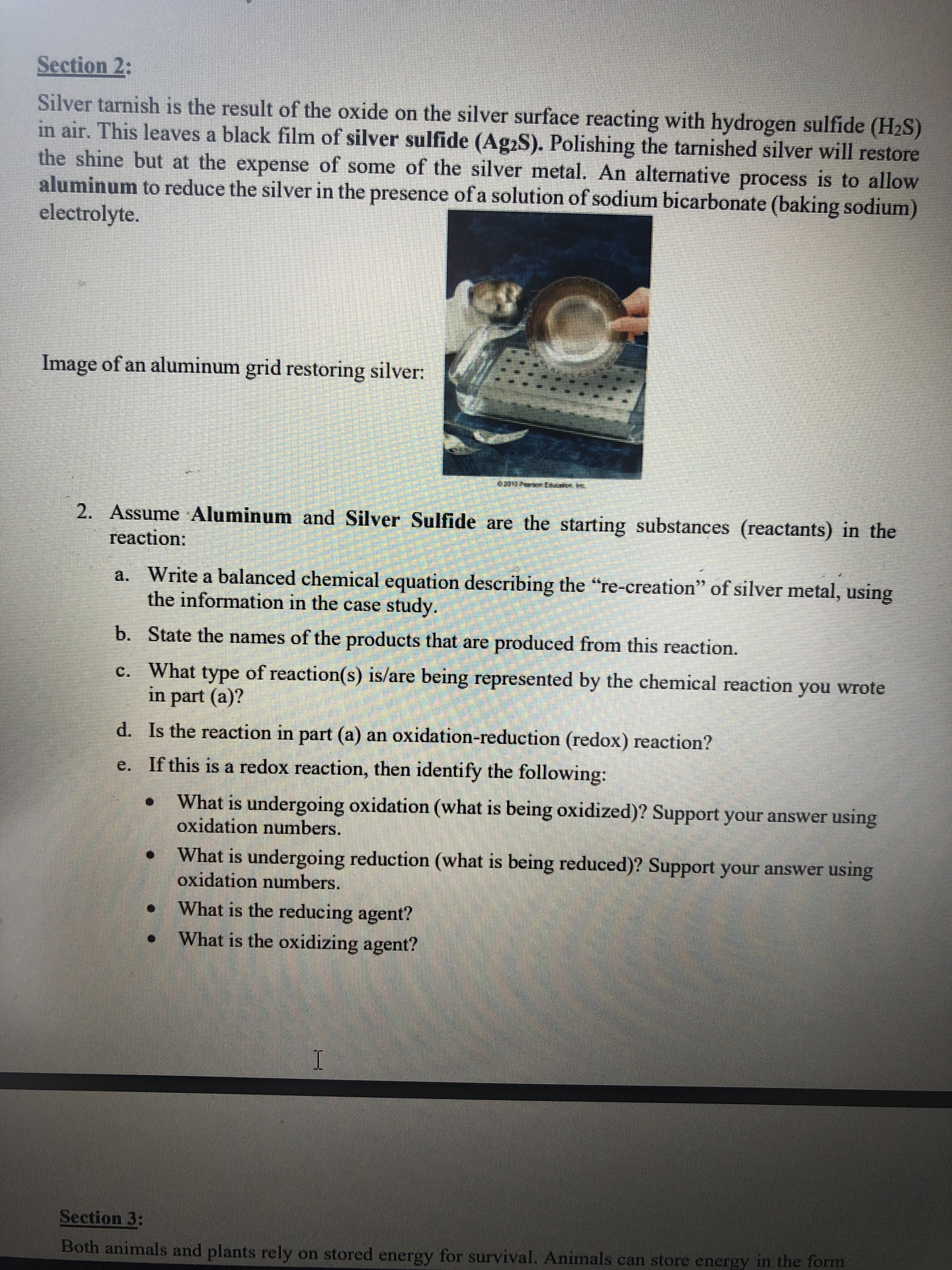Section 2: Silver tarnish is the result of the oxide on the silver surface reacting with hydrogen sulfide (H2S) in air. This leaves a black film of silver sulfide (Ag2S). Polishing the tarnished silver will restore the shine but at the expense of some of the silver metal. An alternative process is to allow aluminum to reduce the silver in the presence of a solution of sodium bicarbonate (baking sodium) electrolyte. Image of an aluminum grid restoring silver: 2. Assume Aluminum and Silver Sulfide are the starting substances (reactants) in the reaction: a. Write a balanced chemical equation describing the "re-creation" of silver metal, using the information in the case study. b. State the names of the products that are produced from this reaction. c. What type of reaction(s) is/are being represented by the chemical reaction you wrote in part (a)? d. Is the reaction in part (a) an oxidation-reduction (redox) reaction? e. If this is a redox reaction, then identify the following: What is undergoing oxidation (what is being oxidized)? Support your answer using oxidation numbers. What is undergoing reduction (what is being reduced)? Support your answer using oxidation numbers. What is the reducing agent? What is the oxidizing agent? Section 3: Both animals and plants rely on stored energy for survival. Animals can store energy in the form
Section 2: Silver tarnish is the result of the oxide on the silver surface reacting with hydrogen sulfide (H2S) in air. This leaves a black film of silver sulfide (Ag2S). Polishing the tarnished silver will restore the shine but at the expense of some of the silver metal. An alternative process is to allow aluminum to reduce the silver in the presence of a solution of sodium bicarbonate (baking sodium) electrolyte. Image of an aluminum grid restoring silver: 2. Assume Aluminum and Silver Sulfide are the starting substances (reactants) in the reaction: a. Write a balanced chemical equation describing the "re-creation" of silver metal, using the information in the case study. b. State the names of the products that are produced from this reaction. c. What type of reaction(s) is/are being represented by the chemical reaction you wrote in part (a)? d. Is the reaction in part (a) an oxidation-reduction (redox) reaction? e. If this is a redox reaction, then identify the following: What is undergoing oxidation (what is being oxidized)? Support your answer using oxidation numbers. What is undergoing reduction (what is being reduced)? Support your answer using oxidation numbers. What is the reducing agent? What is the oxidizing agent? Section 3: Both animals and plants rely on stored energy for survival. Animals can store energy in the form
Chapter4: Types Of Chemical Reactions And Solution Stoichiometry
Section: Chapter Questions
Problem 109AE: The blood alcohol (C2H5OH) level can be determined by titrating a sample of blood plasma with an...
Related questions
Question
For #2 can you please show me all answers for all the parts of the question and explanation

Transcribed Image Text:Section 2:
Silver tarnish is the result of the oxide on the silver surface reacting with hydrogen sulfide (H2S)
in air. This leaves a black film of silver sulfide (Ag2S). Polishing the tarnished silver will restore
the shine but at the expense of some of the silver metal. An alternative process is to allow
aluminum to reduce the silver in the presence of a solution of sodium bicarbonate (baking sodium)
electrolyte.
Image of an aluminum grid restoring silver:
2. Assume Aluminum and Silver Sulfide are the starting substances (reactants) in the
reaction:
a. Write a balanced chemical equation describing the "re-creation" of silver metal, using
the information in the case study.
b. State the names of the products that are produced from this reaction.
c. What type of reaction(s) is/are being represented by the chemical reaction you wrote
in part (a)?
d. Is the reaction in part (a) an oxidation-reduction (redox) reaction?
e. If this is a redox reaction, then identify the following:
What is undergoing oxidation (what is being oxidized)? Support your answer using
oxidation numbers.
What is undergoing reduction (what is being reduced)? Support your answer using
oxidation numbers.
What is the reducing agent?
What is the oxidizing agent?
Section 3:
Both animals and plants rely on stored energy for survival. Animals can store energy in the form
Expert Solution
This question has been solved!
Explore an expertly crafted, step-by-step solution for a thorough understanding of key concepts.
This is a popular solution!
Trending now
This is a popular solution!
Step by step
Solved in 3 steps with 2 images

Knowledge Booster
Learn more about
Need a deep-dive on the concept behind this application? Look no further. Learn more about this topic, chemistry and related others by exploring similar questions and additional content below.Recommended textbooks for you


Chemistry: An Atoms First Approach
Chemistry
ISBN:
9781305079243
Author:
Steven S. Zumdahl, Susan A. Zumdahl
Publisher:
Cengage Learning

Chemistry: Principles and Reactions
Chemistry
ISBN:
9781305079373
Author:
William L. Masterton, Cecile N. Hurley
Publisher:
Cengage Learning


Chemistry: An Atoms First Approach
Chemistry
ISBN:
9781305079243
Author:
Steven S. Zumdahl, Susan A. Zumdahl
Publisher:
Cengage Learning

Chemistry: Principles and Reactions
Chemistry
ISBN:
9781305079373
Author:
William L. Masterton, Cecile N. Hurley
Publisher:
Cengage Learning

Chemistry: Matter and Change
Chemistry
ISBN:
9780078746376
Author:
Dinah Zike, Laurel Dingrando, Nicholas Hainen, Cheryl Wistrom
Publisher:
Glencoe/McGraw-Hill School Pub Co

Chemistry
Chemistry
ISBN:
9781305957404
Author:
Steven S. Zumdahl, Susan A. Zumdahl, Donald J. DeCoste
Publisher:
Cengage Learning

Principles of Modern Chemistry
Chemistry
ISBN:
9781305079113
Author:
David W. Oxtoby, H. Pat Gillis, Laurie J. Butler
Publisher:
Cengage Learning